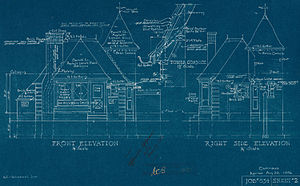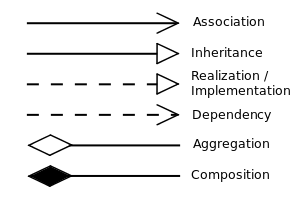W2561 UML Class Diagrams
From Coder Merlin
Revision as of 13:21, 20 June 2019 by Chukwuemeka-tinashe (talk | contribs) (Merlin moved page Project-2561 to W2561 UML Class Diagrams: Improved navigation)
Within these castle walls be forged Mavens of Computer Science ...
— Merlin, The Coder
Prerequisites[edit]
Research[edit]
- Read Class Diagram (Wikipedia)
- Read (Niraj Bhatt)
- Watch UML Class Diagrams (Lucidchart - YouTube)
- Read Counterinsurgency Field Manual (Farnam Street)
Examples[edit]
Dependency[edit]
Alpha uses Bravo as a parameter to Alpha.f(). A transient relationship exists.
class Alpha {
func f(bravo:Bravo) {
bravo.g()
}
}
Aggregation[edit]
Alpha has-a Bravo but Bravo's existence is independent of Alpha.
class Alpha {
var bravo : Bravo?
init(bravo:Bravo) {
self.bravo = bravo
}
}
Composition[edit]
Alpha has-a Bravo and owns Bravo; Bravo's existence is dependent on Alpha.
class Alpha {
let bravo : Bravo
init() {
bravo = Bravo()
}
}
Key Concepts[edit]
- General
- has-a/part-of generally means that one class has (either through ownership or aggregation) another object
- is-a generally means that one class is a subtype of another
- can-do-a generally means that one class can perform some function as described by an interface
- Class Diagrams provide a means for communicating the general, static, conceptual model of an application
- Classes are represented by a box with with three compartments
- The top compartment contains the name of the class, capitalized and centered
- The middle compartment contains the attributes (properties) of the class, left-aligned in camel case
- The bottom compartment contains the operations (methods) of the class, left-aligned in camel case
- Abstract operations are indicated by using italics for the operation name
- An abstract class is indicated by using italics for the class name
- Visibility notations may be placed in front of the attributes and operations
- + indicates public access
- - indicates private access
- # indicates protected access
- Scope notations may be used to specify the scope of attributes and operations
- An underline indicates classifier (static) scope
- The lack of an underline indicates instance scope
- A relationship describes logical connections between entities
- Class-Level relationships
- Inheritance indicates that one of the classes is a specialized form (subclass) of the other (superclass). This is also known as an is a relationship, e.g. "a dog is a mammal". This is indicated on a diagram by drawing a line from the subclass to the superclass with a hollow triangle on the superclass end.
- Realization indicates that one of the classes (the client) realizes (implements) the behavior specified by the other class (the supplier or interface). This is indicated on the diagram by drawing a dashed line from the client to the interface with a hollow triangle on the interface end. The interface itself has an <<interface>> tag above the "class" name.
- Instance-Level relationships
- A dependency represents a semantic relationship between two elements. It is represented as a dashed line with an arrow head pointing in the direction of the dependency. Note that actual interaction may be transient and limited to a class reference as an argument to a method.
- An association represents a tighter link than a dependency when the relationship generally exists throughout the lifetime of the class as a reference to another class.
- A unidirectional association is represented as a solid line with an arrow head pointing in the direction of the association.
- A bidirectional association is represented as a solid line between the classes.
- Aggregation is a form of weak association with a "part-of" relationship, where the contained classes do not have a lifecycle dependency on the container yet are "used" by it. It is represented with a hollow diamond on the containing class with a line drawn to the contained class.
- Composition is a form of strong association where the contained class is "owned" by the container. It is represented as a filled diamond on the containing class with a line drawn to the contained class.
- Class-Level relationships
Exercises[edit]
- Construct a UML diagram (either on paper or electronic tool such as www.draw.io). Be sure to include all important properties and methods and ensure that relationships between classes are represented correctly.



